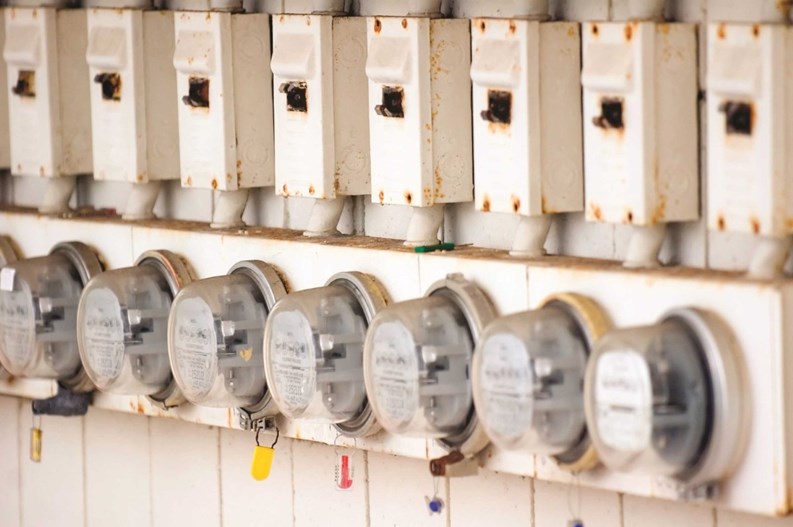It’s a beautiful Friday night and you’re out to dinner with four of your best buddies. The restaurant's ambiance is exquisite and the food is divine. You’re on a budget, so you stick to ordering a delicious appetizer and some tasty soup, while your friends go all in on surf and turf, quaff glasses of the restaurant’s best champagne and devour decadent desserts. The fun and laughter lasts for hours. You’ve had the time of your life—but when the check comes, your friends insist upon dividing it equally among the five of you, despite the fact that your meal cost only a fraction of theirs. Sighing, you hand over your credit card, feeling distinctly taken-advantage-of.
Hopefully you don't have friends who would pull a stunt like that at a restaurant, or anywhere else. If you're a resident of a multifamily building where you don’t have direct billing for your utilities however, this scenario is an everyday occurrence. Regardless of what you personally consume, you're picking up the tab for your neighbor’s water, gas and electric use. Unless you have submetered utilities, that is.
Breaking Up is Hard to Do
Many buildings are still master metered. “In a master metered building, the electricity charges are folded into the monthly maintenance charges (which are sometimes referred to as common area charges),” says Dean Zias, a project manager with the New York State Energy Research & Development Authority (NYSERDA), a public benefit corporation that offers objective information and analysis, innovative programs, technical expertise and funding to help New Yorkers increase energy efficiency, save money, use renewable energy and reduce reliance on fossil fuels. “So the electricity costs are treated much like fees for snow removal or grass cutting,” he says.
Zias explains that the building tallies up the total electricity charges—including demand and consumption (kW + kWh)—and divvies up the charges among residents within their maintenance bill. “The charges are divided by either the square footage of the unit, or by the number of shares a cooperator or owner has,” he says. “Apartments at the top of a building, for example, are more desirable, so owners of these units typically have more shares.”
Zias says that the real drawback of billing this way is that there is no incentive for shareholders or unit owners to save energy—the costs are buried among their general maintenance fees. “Most boards only look at maintenance expenses annually,” he says. “At that time, they might decide expenses are too high, and begin looking at ways to make energy efficiency improvements. It’s really a big disconnect in the ability to close the loop and look at electricity costs more often. It’s also hard to get data on in-unit consumption to see where opportunities to save energy and costs can be found.”
An Old Idea
Submetering was introduced in multifamily buildings as far back as the 1920s, but didn’t really become a concept in the property management industry until the 1980s when energy costs and conservation became more of a concern for property owners. Eric Jacobson, director of corporate communications for Quadlogic Controls Corp. in Long Island City explains that submetering was prohibited for a number of years after landlords were found to be gouging rental tenants, but it was re-enabled in the late 1970s.
“Submetering is a highly contentious subject in the building industry,” says Herbert Hirschfeld, PE, a professional engineer and an energy consultant based in Glen Cove. “In a rental building, anything the landlord wants to do, the residents tend to feel the landlord is out to screw them. It’s an adversarial relationship between renters and landlords. The elderly are also sometimes afraid of change. They feel preyed upon by shareholders looking to defeat the measure. Co-ops aren’t as adversarial, but sometimes an existing board will want to submeter the co-op but the next board of directors will take the opposite position. It’s like the Democrats and Republicans.”
Seeking the approval of non-board shareholders or the majority of the residents in a co-op or condo is no longer needed to switch from master metering to submetering. The Public Service Commission (PSC) regulations issued in December 2012 state that the decision to proceed with submetering can now be made by a board unilaterally.
To be clear: submetering is not the same thing as real-time billing, under which consumers pay the actual price for electricity at that moment in time when it’s used (the cost is often applied in 15-minute increments). “This form of billing applies more to the industrial and commercial sectors,” says Zias. “Under real-time pricing, you could be paying up to $80 dollars per kWh, depending upon the time of day and the season (summertime being the highest). Users pay the lowest price for electricity in the evening time, mid-range during dawn and dusk periods, and the highest prices during the day. To protect consumers from high electricity prices, legislation was passed in the1980s forbidding real-time billing for the residential sector, so you won’t see this very often in residential buildings today.”
According to Jacobsen, Quadlogic invented the technology of electric meters that are installed in the apartment or condo unit and read remotely. “Our meter gets installed adjacent to the circuit breaker panel; that’s the only place they can measure the usage here,” he says. “We impose our data signal on the robust, strong wiring that's already there, and we use that on a data network. Our patent has to avoid the frequencies where there is noise on the power line. We do it to avoid interference, so the data has integrity and is recorded by the transponder. Otherwise it’s rejected. This process is repeated every 24 hours, so it's continuously optimizing.”
For direct meter, a meter room needs to be installed, usually in the basement. “An individual meter for each unit also needs to be installed, and the apartment’s electrical panel must then be wired to the direct meter (which typically requires wiring to be done through the interior walls),” says Zias. “This is a major capital cost.”
The submeters are installed next to the electrical junction (or fuse) box by installing a current transformer in the unit. “Because wires already exist in the units, the installation is faster and less disruptive,” says Zias. “In fact, the installation of the submeter in the unit can be done in an hour or two (to mount the box and connect the wires).”
Incentives to Implement
NYSERDA's Advanced Submetering Program is for buildings with five or more units. It provides incentives to help buildings convert to a master meter and advanced submeters, where every unit is metered and residents pay for the energy they use in their individual units. NYSERDA pays 50 percent of the installed cost, up to $250 per submeter, and also provides incentives for efficient refrigerators and in-unit lighting so residents see optimum savings in their electric bills.
“Submetering technology also requires less physical space,” says Jacobsen. “That’s one key point that it’s more space efficient and less expensive than building banks of meter rooms. A lot of condos and co-ops don’t want to see meter readers. They like the idea of remote readers as opposed to manual. There are no mistakes. The underlying concept is that it’s less expensive to reduce consumption than to generate more power.”
“For the advanced submetering option, you need a way to transmit and read the data off the meters, customarily in 15-minute intervals,” says Zias. “This requires a communication infrastructure. There are two ways to do this. The first is through a powerline carrier that transmits the data back from the building. The second way is through radio frequency. Any building can be retrofitted.”
The installation process depends on the number of units. Lewis Kwit, president of Energy Investment Systems in New York City is retained to develop submetering programs for various buildings. “It’s changed in the last year or so because the Public Service Commission instituted new regulations in 2012,” he says. “Instead of the old requirement of having shareholders to vote to submeter or not, the building has to file an application. They must submit a petition with many documents that have a lot of consumer protections in it.”
For example, Kwit says that buildings have to offer a building level sustainability program, which lets occupants participate in conservation efforts. “They also have to offer a deferred payment plan if they get behind. There are protections that have to be addressed, even in low-income buildings. The other thing that’s interesting to us is that the other meters have to be terminable. They have to be able to be turned off, so they don’t get their electricity.”
Sticker Shock
Like our poor buddy at the beginning of this article who suffered sticker shock when the dinner bill arrived, residents often react with shock at their first submetered utility bill. “It’s sticker shock for them, too,” says Jacobsen. “So they start to turn lights off. They do the common sense things to save money.”
Hirschfeld says that two of the most successful examples of submetering are Georgetown Mews in Queens and Jefferson Towers in Manhattan. Georgetown Mews is a master-metered cooperative containing 37 two-story residential buildings with 33 utility master meters located in Queens. According to the study, this complex contained a mixture of approximately 85% shareholders and 15% rent stabilized tenants in a total of 930 apartments. The study showed a 20.89% reduction of the adjusted electrical usage and an associated cost avoidance of $272,229 or 20.95%.
According to Hirschfeld’s report, Jefferson Towers, a master-metered, high rise cooperative with 190 units on the Upper West Side of Manhattan implemented electrical submetering during 2003 utilizing a NYSERDA incentive. In 2010, Jefferson Towers also participated in a NYSERDA-sponsored program to replace its air conditioners with new units, controlled by the existing submetering system. The report shows a cost reduction of 21%.
NYSERDA also has two case studies that have gone through its advanced program. According to their reports, Tower East is a co-op building that relied on a single electric master meter. Converting to submetering qualified for $34,000 in NYSERDA incentives from NYSERDA, leading to a 20% reduction in costs.
Park City Estates is a Queens co-op that used a single master meter in each of its five buildings. The NYSERDA Advanced Submetering Program provided over $265,000 in incentives, leading to a 15% drop in maintenance costs, and subsequently, a rise in property values.
“Now there’s time sensitive pricing too,” says Hirschfeld. “You pay for electricity when you use it. With the old metering system, that was virtually impossible, because there was no way of separating the energy usage. Recent technology allows a meter reading company to separate consumption from various periods.
Buildings undertaking submetering have the option to do their own billing or they can have a billing service handle the task.
When it comes to submetering costs, Zias says there are several things to consider. “The submetering monthly billing charge is $3 to $4 per month per unit,” he says. “The bigger the building is, the closer this fee will be to $3. Smaller buildings typically pay $4 per month, per unit. In submetered buildings, the cost for electricity will be a flat rate, often called a bulk rate. In buildings doing real-time billing, the cost for electricity will depend on the actual electricity rate at the time the electricity is consumed (pricing is adjusted in 15-minute intervals). In direct-metered buildings, the utility company needs to read the bill. This cost can be $17-$19 a month. (This is a hidden savings when moving to submetering).”
Associations and boards can spend money on many conservation measures, but as far as most energy professionals are concerned, submetering is probably one of the more cost-effective alternatives.
Residents and the owners alike save money, and it’s good for the environment—and those two benefits most likely outweigh the cost and administrative hassle of switching over.
Lisa Iannucci is a freelance writer and a frequent contributor to The Cooperator.







Leave a Comment